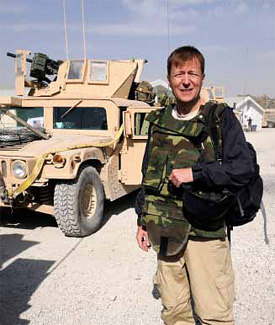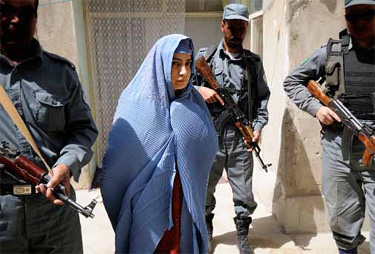Merging Print & Video: Profile - Roger Arnold
Name: Roger Arnold

Arnold preparing for an embed with US Marines in AfghanistanHome: Florida
Currently based: Bangkok, Thailand
Occupation: Cameraman/Photographer
Current assignments:
I just finished shooting part of a long term documentary for Boo Films, a company based in Malaysia, based on conflict photography. I shoot video fairly regularly for the Wall Street Journal in Thailand, most of which focuses on the ongoing political conflict. I have a number of assignments lined up with the UN in Asia.
Have you been busy?
Yes. But I would like to be busier with video. I still produce some photo and text magazine features but a majority of my work over the last year has been video. I still like telling a good print feature story, but the money and opportunities keep shrinking.
Shooting where?
Primarily shooting video in Thailand and Myanmar. I’ve been on the verge of returning to Afghanistan for several projects but none of them have come through yet. I’m likely headed to the Philippines and Bangladesh for my next assignments.
What types of production have you mostly shot?
The productions that I have worked on most usually involve conflict and going to remote and difficult to reach places. In some cases it was because the media company preferred that I assume the risks instead of putting one of their correspondents in danger. In one case we were trying to link up with a rebel group that was on the run being shelled, which required a lot of time and patience. Another required traveling deep into Myanmar to a remote area controlled by the United WA State Army.
What are the challenges of shooting for new online outlets?
With some of the new online entrants, one of the biggest challenges is they sometimes don’t know what they want. One time I had an editor in Asia telling me my camera wasn’t good enough, even though it was far superior to the unit they had requested the week before. Some of their correspondents were using Flip cameras that were of much lower quality, which left me really frustrated.

Malalai Joya, who spoke in the Afghan Parliament against warlords and alleged criminals in the government The chief editor in Europe thought my camera was more than good enough and was only concerned with making sure the video story properly supported the text. I think some, perhaps a lot, of the online sites are still deciding what they want to be technically and content-wise. One problem is the print people are usually in charge, so video often ends up being the stepchild in what should be an integrated online story.
What were your experiences in Afghanistan?
All of my published work there has been photo and text magazine features and work for several NGOs and UN agencies. I have one proposal out at the moment that may take me back there later this year.
How do you find getting around Asia?
It all varies from country to country and what you are trying to do. It has become more difficult to travel to Myanmar legally, but the policy at different embassies fluctuates. The Thais are generally very good to work with and you can work on most subjects without any hassles.
With the convergence of DSLRs shooting HD video (aka Canon 5D MkII), are you heading this way, gear-wise?
I’ve shot a lot with the Canon 5D. I’m hoping its replacement will address a lot of its deficiencies in controlling and monitoring sound as well as auto focus. Two LCD screens would be a huge improvement too; one as a flip-out screen the second as a fixed screen where an eye cup could be mounted.
What was your first ever shooting job?
My first real video assignment came from the Wall Street Journal last year during the Red Shirt protests that paralyzed central Bangkok. The protests lasted two months and I made about 20 videos during that time. One ended up winning The Rory Peck Award for News. The editors at the Wall Street Journal were great. They let me go out and shoot whatever I thought the story was that day. They knew I understood the story since the protest camp was right next to my apartment and I had been there every day for two months.
Most recent, interesting assignments?
I shot a video interview with Thailand’s current Prime Minister, Abhisit Vejjajiva, the second time in less than a year. He didn’t reveal anything major, but I think it’s interesting any time you gain access to a world leader and the people that make his government work, especially at what could be a pivotal moment in Thai history. The most interesting story I’ve done was in Laos in 2006 called Still A Secret War. You can see a short multimedia piece about it on my website.
Current equipment you use?

A young Hmong boy stands guard in the jungle while his group rests, near Vang Vieng, Laos. I use a Canon 5D, Rode VideoMic, Sony UWP-V1 wireless Lavalier, Sony PCM D50 field recorder for backup audio, and a Manfrotto tripod. I also have a small Panasonic HDC-TM700 camcorder that, for its size, does a lot of things pretty well. It is good in environments where you don’t want to attract too much attention.
Other gear you have access to?
Sony EX1R.
Equipment “wish list”?
Some of the smaller Sonys are on my list, like the HDR-AX2000 AVCHD camcorder, which is light and low in price. I’m really waiting to see what Canon releases as the successor to the 5D before making a decision.
What piece of gear do you wish someone might make?
Something like the Sony HVR-A1E with a chip that captures video with the quality of the Canon 5D and records to Flash memory, along with a few more pro features like ND filters and externally accessible controls.
Best thing about your job?
The best thing is flexibility and being able to do unusual stories on fascinating subjects.
Worst thing about your job?
Looking for new work, keeping a balance, and juggling the demands of being freelance.
Dullest assignments and why?
I find the pressure to do a good job puts me on edge and gives me a nervous energy that fortunately I’m able to channel in a good way, even if the topic might sound dull. The only thing that can be dull is not having an assignment.
Hairiest/scariest assignments and why?
Last year’s Red Shirt protests in Bangkok were difficult. I had seven journalist friends or acquaintances who were shot or hit by grenades during that time. Unfortunately, one I’d known only for a few weeks was killed. I’d rather talk about an inspiring Australian cameraman named Neil Davis who really did amazing work during the Vietnam war before he was killed here in Bangkok in 1985. Everyone should see David Bradbury’s film on Davis called Frontline. Many regard Davis as the finest cameraman from the war.
How much 16:9 do you shoot?
A lot with my Panasonic.
What country would you most like to shoot in?
Afghanistan. It’s such an amazing, beautiful and difficult place.
What’s your taste in music?
Anything but jazz. The Doors and The Rolling Stones are favorites. I’m not from that generation but the music that came out of the 60s and early 70s is still the best.
Favorite food?
Sushi or a hamburger, though I rarely eat hamburgers anymore.
Contact details:
P: +66 (0)87 235 0732
E: rogerarnold7@yahoo.com
W: rogerarnold.net
The professional video industry's #1 source for news, trends and product and tech information. Sign up below.
